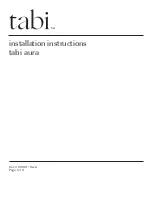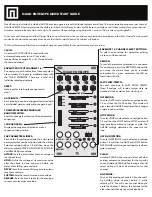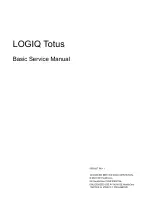
Faultfinding Guide
GB 60
CDR779
8.
capacitor at the Vcc pin will discharge because the primairy
auxiliary voltage, coming from winding7-9 is below the Vcc
voltage. At some moment during t2, the primary auxiliary
voltages reaches the same level as Vcc.
This primary auxiliary voltage now determines the Vcc
voltage
t3: regulation
The output voltage of the power supply is in regulation
t4: overload
When the output is shortened, the supply voltage of the
circuit will decrease and after some time drop below the
lower threshold voltage. At that moment, the output will be
disabled and the process of charging the Vcc capacitor starts
again. If the output is still shorted at the next t2 phase, the
complete start-and stop sequence will repeat. The power
supply comes in a hiccup mode.
Figure 8-12
8.2.5
Regulation
Figure 4 shows the most relevant signals during the
regulation phase of the power supply.
The oscillator voltage ramps up and down between V1 and
V2. The voltage at the current sense terminal is compared
every cycle with the output of the error amplifier Vcomp. The
output is switched off when the current sense level exceeds
the level at the output of the error amplifier.
TimeON phase : A drain current will flow from the positive
supply at pin 1 through the transformer’s primary winding, the
MOSFET and Rsense to ground. As the positive voltage at
pin 1 of the transformer is constant, the current will increase
linearly and create a ramp dependent on the mains voltage
and the inductance of the primary winding. A certain amount
of energy is stored in the transformer in the form of a
magnetic field. The polarity of the voltages at the secundary
windings is such that the diodes are non-conducting.
TimeDIODE phase : When the MOSFET is switched off,
energy is no longer supplied to the tranformer. The
inductance of the tranformer now tries to maintain the current
which has been flowing through it at a constant level. The
polarity of the voltage from the transformer therefore
becomes reversed. This results in a current flow through the
tranformer’s secondary winding via the diodes, electrolytic
capacitors and the load. This current is also ramp shaped but
decreasing.
TimeDEAD phase : when the stored energy has been
supplied to the load, the voltage from the secondary windings
falls below the output voltage(held constant by the
electrolytic capacitors) plus the threshold voltage of the
diodes. The current in the secondary winding stops flowing.
At this point, the drain voltage of the MOSFET is not yet zero
because C2609 between drain and source contains a certain
charge. This charge will start a sine-shaped ringing together
with the transformer’s self-induction.
The oscillator will start a next cyclus which consists of the
described three phases. The time of the different phases
depends on the mains voltage and the load.
TimeDEAD is maximum at an input of 400VDC and minimum
load, it will be zero at an input of 100VDC and overload.
Figure 8-13
Figure C : Start-up sequence
1mA
t1
Vo
0
OUTPUT
t2
t3
t4
short
Vcc
Vc2134
Icc
20mA
0V
10V
16V
12V
CL 06532151_020.eps
271100
Vosc
Idiodes
Vgate
Vdrain
Idrain
Vsense
Vcomp
0
V2
V1
Ton
Tdiode Tdead
CL 06532151_021.eps
271100
















































